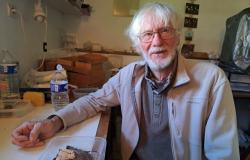Par
Patricia Bigot
Published on
Oct. 2 2024 at 6:28 am
See my news
Follow L’Écho de la Presqu’île
“If you start getting interested in slime molds, you won’t get out of it.” The phrase sounds like a friendly warning. Because René Le Goff, resident of Saint-André-des-Eaux (Loire-Atlantique) knows something about it, he who “fell into it”, as he himself said in 2006. Retired for thirty years, this Andréanais, member of Bretagne Vivante, is above all a nature enthusiast: after wild orchids, grasses, lichen, here it is literally melting for the slime molds or more commonly called blobs (name given to the yellow-colored Physarum polycephalum species, by CNRS researcher Audrey Dussutour).
It was during an exhibition, after joining the mycological group of Saint-Nazaire. I started collecting them in 2006, because you can find them everywhere!
Neither mushroom nor animal
The retiree gets to know Marianne Meyera specialist in this unicellular organism (protist), now deceased, to whom she devoted works and various articles.
The slime mold is close to amoebae: it is neither a fungus nor a plant nor an animal. In the beginning, it is even invisible to the eye. To observe it, René is well equipped.
The octogenarian went from large to small format: after learning the basics of cartography, which he was once passionate about, he learned microscopy.
A very useful discipline when it comes to studying the slime molds found in nature, under a pile of fagots, on the stump of a tree…
With a camera to which I added a trinocular magnifying glass, I can see on the order of a millimeter. This makes for magnificent photos.
Because the development of the slime mold (also wrongly called champion animal) is intriguing.
Its originality is based on a cell with several nucleiwhich enlarges and becomes visible in the form of a plasmodium, similar to veins that colonize a space.
Movement of 1 cm per hour
At this stage it is mobile and this plasmodium is looking for food. It moves approximately 1 cm per hour by vibratory movement. I keep it in a box with a moistened sheet of paper. It does not like light or cold, and feeds on oat flakes or, as here, with branches of maritime pine that I had put in the water.
Then, it can go dormant and become “dry” when conditions are not favorable for it (drought for example) or fruit.
“There it is inert and it metamorphoses. It reproduces by bursting and diffusing its spores like mushrooms, hence the confusion, upon its discovery, on its classification”, recalls the Andréanais to theEcho of the peninsula.
177 species in Loire-Atlantique
Drawn since the 1600s, the slime mold was considered a flower and then appeared among the mushrooms until the 1970s.
Today there are 1,000 species listed and René Le Goff actively participates at the department level, with Fabrice Ribollet.
Together, they published an inventory: there are 177 in Loire-Atlantique including 77 in Saint-André-des-Eaux, “and 44 in my garden… Some are even very rare”. Names are sometimes not easy to remember, except for René.
One detail, precisely, the term “blob” hardly pleases the Andréanais. But he admits that it had the merit of drawing attention to a subject that few naturalists tackle.
And above all, as he recalls, the work ofAudrey Dussutour made it possible to move forward on the subject.
“The blob has memory”
It is thanks to her that we know that he can learn and memorize. She has carried out experiments which demonstrate that it can transmit information to another blob, for example by merging with it.
The blob is also able to find the quickest route to a food source and remember places it has already explored.
A source of astonishment which always delights René and which he also knows how to pass on to the curious who come to meet him at trade fairs or during outings in the forest like that of Gâvre.
You can meet René Le Goff at the mushroom and invasive plants show on October 26 and 27 (10 a.m./12 p.m.-2 p.m./6 p.m.), Immaculée multipurpose room in Saint-Nazaire (entrance: €2, free under 18 years old).
Follow all the news from your favorite cities and media by subscribing to Mon Actu.







